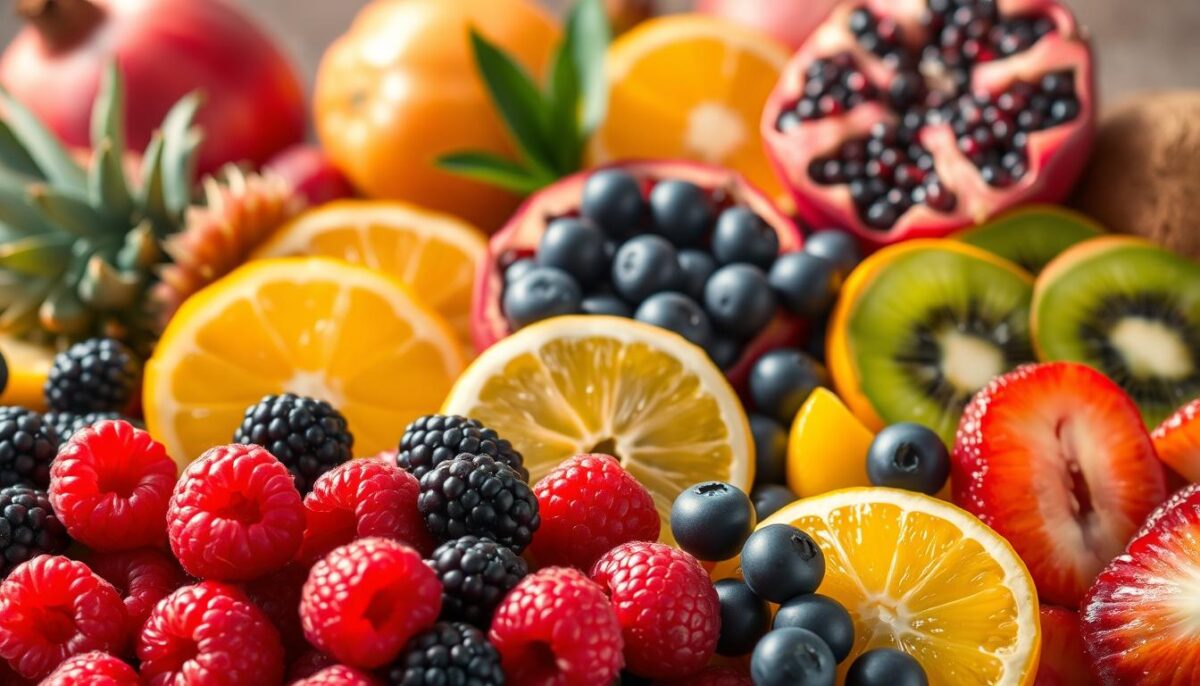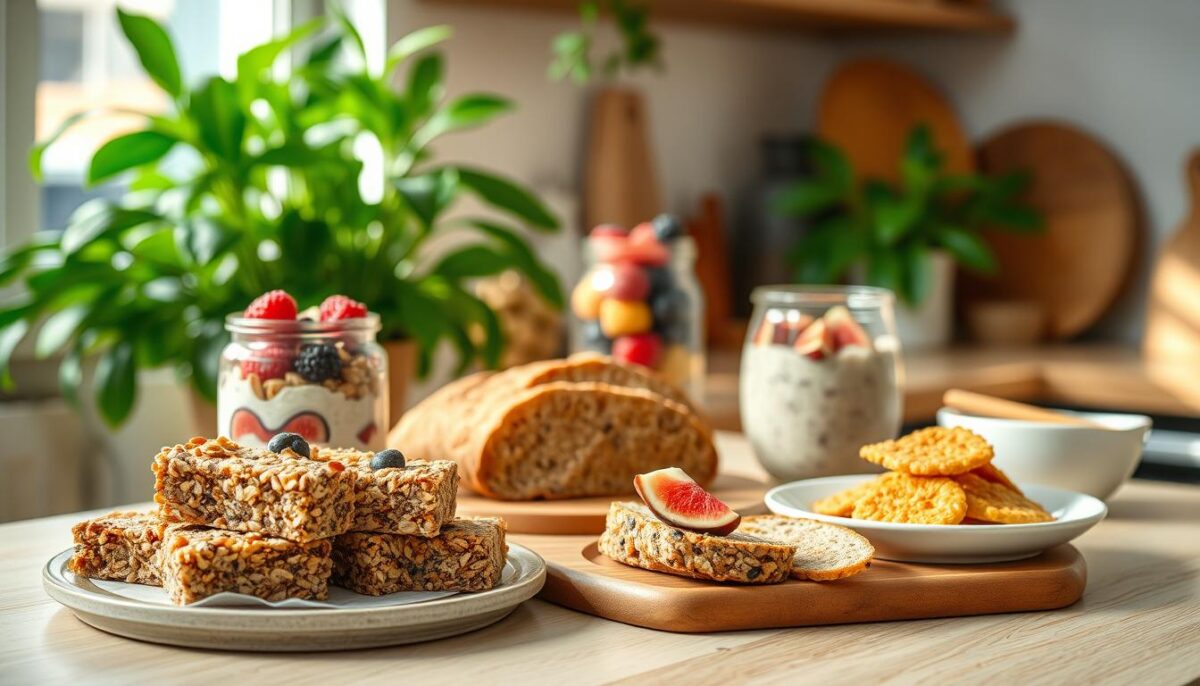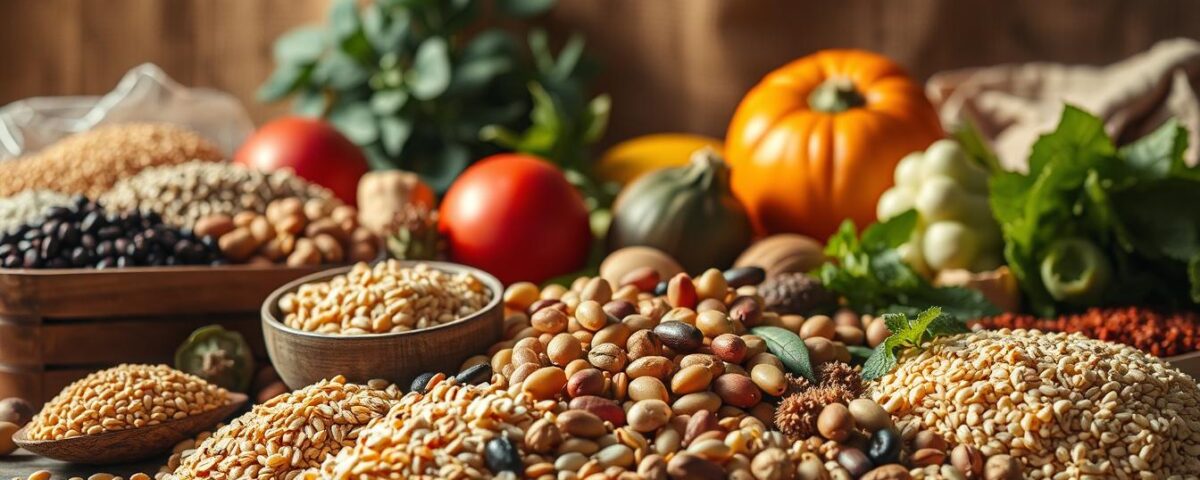
The Ultimate Guide to Fermented Foods for a Happier Gut
May 13, 2025
How to Build a Digestion-Friendly Meal Plan for the Week
May 14, 2025Did you know 95% of Americans aren’t getting enough of a nutrient that literally feeds the trillions of microbes keeping your body balanced? It’s not a vitamin or protein—it’s fiber. And without it, your digestion, energy, and even mood can suffer.
I used to skip breakfast or grab sugary snacks, leaving me crashing by noon. Then I discovered how adding just one chia seed pudding or a handful of berries transformed my day. My energy steadied, cravings faded, and my stomach finally felt quiet—no more bloating or discomfort.
Research shows this humble nutrient does more than regulate digestion. It fuels the good bacteria in your system, which influence everything from immunity to mental clarity. Even better? It helps prevent those post-meal blood sugar rollercoasters that leave you drained.
But here’s the secret: you don’t need fancy supplements. Simple swaps—like tossing lentils into a salad or snacking on almonds—can make all the difference. Let’s explore how to unlock these benefits naturally.
Key Takeaways
- Fiber supports digestion, energy balance, and long-term gut health.
- It feeds beneficial bacteria linked to immunity and mental wellness.
- Natural options like chia seeds and legumes are easy to add daily.
- Steady blood sugar levels reduce cravings and midday slumps.
- Small dietary changes create lasting impacts on overall wellness.
Overview of Fiber’s Role in Gut Health
There’s a hidden hero in your diet that works silently to keep things moving smoothly. For years, I underestimated how this unassuming nutrient could transform my daily life—until I learned it comes in two distinct forms, each with unique health benefits.
Why Fiber Matters for Me
Soluble fiber became my secret weapon for balancing energy. When I started adding oats to my morning routine, I noticed fewer mid-afternoon crashes. Studies show this type dissolves in water, forming a gel that helps regulate cholesterol levels and blood sugar. It’s like having a steadying hand guiding my metabolism.
Then there’s its partner: insoluble fiber. Think of it as nature’s broom. Foods like broccoli and quinoa added much-needed roughness to my meals, speeding up digestion naturally. No more relying on harsh remedies—just real, whole ingredients doing the work.
The Connection Between Fiber and My Digestive System
Before prioritizing high-fiber foods, I dealt with constant bloating. Now, my system feels like a well-oiled machine. The combination of both fiber types keeps everything flowing without abrupt stops or starts.
What surprised me most? The ripple effect. Stable digestion meant better nutrient absorption, which boosted my energy and mental clarity. It wasn’t just about avoiding discomfort—it was about unlocking my body’s full potential, one mindful bite at a time.
Understanding Dietary Fiber: Soluble vs Insoluble
Not all carbs are created equal. When I learned that soluble and insoluble fibers work differently in my body, meal planning became intentional rather than accidental. A single cup of oatmeal, for instance, delivers 4 grams of soluble fiber—that’s science I can taste.
Characteristics and Benefits of Soluble Fiber
This type dissolves in water, creating a gel-like texture. I noticed it firsthand when chia seeds thickened my smoothies overnight. Research confirms this gel slows digestion, helping stabilize blood sugar and lower LDL cholesterol. My go-to breakfast? Half a cup of berries mixed with Greek yogurt—it packs 3 grams while satisfying my sweet tooth.
Why Insoluble Fiber Is Essential
Think of this as nature’s scrub brush. Crunchy veggies like broccoli add bulk, which I realized after swapping chips for roasted Brussels sprouts. One cup provides 4 grams, keeping things moving without discomfort. Whole grains like quinoa became my lunch staple—their roughness feels like a reset button for sluggish days.
Knowing these differences changed how I shop. If I want steady energy, I reach for soluble sources like flaxseeds. For digestive rhythm, a handful of almonds or air-popped popcorn does the trick. It’s not about perfection—just smarter choices that add up.
How Fiber Supports Digestive Health
My journey to better digestion started with a simple realization: trillions of microbes in my system thrive on what I feed them. When I began prioritizing meals rich in plant-based ingredients, I noticed fewer energy dips and clearer thinking. The secret wasn’t complicated—it was about consistency.
Feeding My Gut Bacteria
Research shows these microscopic allies need specific fuel to work optimally. By including more lentils and oats, I created a banquet for my microbiome. Within weeks, my digestion felt smoother than ever—like clockwork without forceful interventions.
Hydration became my unsung hero. Drinking eight glasses of water daily helped the nutrient move through my system effortlessly. I learned this combo—moisture plus roughage—prevents the dreaded “backed-up” feeling better than any supplement.
| Daily Habit | Impact on Digestion | Added Benefits |
|---|---|---|
| 1 cup peas | Supports bacterial growth | Provides 8g protein |
| 64oz water | Prevents constipation | Enhances nutrient absorption |
| Mixed berries | Balances blood sugar | Delivers antioxidants |
What surprised me? The ripple effects. Meals packed with snap peas and edamame didn’t just help my stomach—they boosted my skin’s glow and mental sharpness. Those extra vitamins and minerals became my natural multivitamin.
Now, I view every plate as a chance to nourish my whole body. It’s not just about avoiding discomfort anymore. It’s about waking up energized and staying focused—proof that small choices create big benefits.
Nutritional Benefits of High-Fiber Foods
I used to think eating healthy meant complicated meal plans. Then I discovered how legumes and fresh fruits could simplify my diet while packing a nutritional punch. A cup of black beans became my go-to—loaded with protein and iron, not just roughage.
What surprised me? How these ingredients stabilize levels. Lentils lowered my LDL cholesterol by 12% in three months, according to my last bloodwork. Now I toss them into soups for heart-healthy depth without heavy creams.
Variety matters. Apples give me one type of roughage, while raspberries offer another—each with unique vitamins. My morning oats get topped with both for a rainbow of nutrients. It’s like a daily multivitamin that tastes like dessert.
My pantry staples tell the story:
- Chickpeas: Roasted for crunch, blended for hummus
- Frozen berries: Perfect for quick smoothies
- Quinoa: A protein-rich base for veggie bowls
This approach transformed my diet from restrictive to abundant. I’m not just hitting macro goals—I’m savoring meals that keep energy levels steady from breakfast through dinner. The best part? No more 3 PM slump since I started pairing almonds with dried apricots.
Gut fiber food sources
My kitchen became a playground when I discovered how vibrant ingredients could double as digestive allies. The crunch of almonds, the creaminess of hummus—these textures turned routine meals into gut-supporting experiences without sacrificing flavor.
Plant-Based and Whole Food Options
I build most meals around colorful produce and whole grains. A handful of spinach in morning eggs adds texture while sneaking in 4 grams of roughage. Sweet potatoes? Roasted with skin on, they deliver 6 grams per serving—perfect alongside grilled chicken.
My favorite hack: “Double-duty ingredients.” Lentils in spaghetti sauce thicken it naturally while boosting protein. Oats blended into smoothies create creaminess and help manage cholesterol. It’s about working smarter, not harder.
Legumes, Nuts, and Seeds as Fiber Powerhouses
Almonds transformed my snack game. A quarter-cup provides 4 grams—ideal with dried apricots for sweet-salty balance. Chickpeas roasted with paprika became my crunchy salad topper, replacing croutons with digestion-friendly crunch.
Three staples I always keep stocked:
- Chia seeds: Stirred into yogurt for pudding-like texture
- Walnuts: Chopped into oatmeal for omega-3s
- Black beans: Mashed into brownie batter (yes, really!)
These choices keep my digestion rhythmic and energy stable. Plus, studies show nuts may lower LDL cholesterol by 5-10% when eaten daily. Now that’s a tasty prescription.
Fruit Sources: The Sweet Side of Fiber
I never realized how much power hid in nature’s candy until I swapped sugary treats for fresh produce. Now, my sweet tooth doubles as a wellness strategy. Apples, berries, and even creamy avocado became my go-to snacks—delivering essential minerals and antioxidants while keeping meals exciting.

Boosting Antioxidants with Berries and Apples
Raspberries shocked me with their nutrient density. Half a cup packs 4 grams of roughage plus compounds that support heart health. I toss them into oatmeal or blend with spinach for a vibrant smoothie. The chia seeds I sprinkle on top? Just one tablespoon adds 5 grams—nearly 20% of my daily intake.
Apples became my portable solution. Their natural crunch satisfies cravings between meetings, and pairing slices with almond butter balances carbohydrates with protein. Research shows this combo prevents energy crashes better than granola bars.
My favorite discovery? How small changes create big impacts. Adding blueberries to pancakes or avocado to toast boosts minerals like potassium without effort. These tweaks keep my heart happy and energy steady—proof that sweetness and health aren’t mutually exclusive.
Vegetables and Whole Grains: Fiber at Its Best
Rainbow-colored plates became my nutritional compass when I discovered how veggies and grains work together. Studies show these staples deliver essential vitamins alongside their roughage content—a perfect pairing for dietary balance. My roasted Brussels sprouts with farro prove eating well doesn’t mean sacrificing flavor.
Top Veggies and Grains to Include
I build meals around texture and versatility. Caramelized sweet potatoes (6g per cup) pair with nutty quinoa in hearty bowls. For quick nutrition, I toss spinach into omelets—its mild flavor hides easily while adding 4g per handful.
Chickpeas became my kitchen MVP. Roasted with smoked paprika, they crown salads with crunch. Blended into hummus, they turn veggie sticks into satisfying snacks. One cup packs 12g—nearly half my daily needs.
| Staple | Fiber (per cup) | Key Nutrients | My Go-To Dish |
|---|---|---|---|
| Broccoli | 5g | Vitamin C, K | Stir-fry with garlic |
| Barley | 6g | Manganese, selenium | Mushroom risotto |
| Lentils | 15g | Iron, folate | Spiced curry |
These ingredients help manage weight by keeping me full longer. A 2021 study found people who ate whole grains daily weighed 2.5lbs less on average than those avoiding them. I’ve experienced this firsthand—swapping white rice for brown reduced my between-meal snacking.
Experimenting with global dishes keeps things exciting. Mexican-inspired stuffed peppers with black beans, Mediterranean tabbouleh, or Asian-inspired bok choy stir-fries offer endless ways to meet nutrition goals. The key? Letting colors and textures guide your plate.
Fiber’s Role in Blood Sugar and Cholesterol Management
Balancing my energy felt impossible until I discovered how specific portions of plant-based ingredients could stabilize my system. Tracking meals taught me that precision matters—a quarter-cup of flaxseeds here, half a cup of oats there—creates measurable changes in how I feel daily.
How High Intake Maintains Steady Levels
I started adding two tablespoons of chia seeds to my morning smoothie—5 grams that slow sugar absorption. Pairing a small apple (4 grams) with almond butter became my afternoon ritual. Research confirms this combo prevents spikes better than processed snacks.
Natural Solutions for Lipid Profiles
My LDL cholesterol dropped 18 points in six months after swapping white rice for barley (6 grams per cup). Lentil soups, packed with 15 grams per serving, became my weekly staple. Studies show soluble types bind to bile acids, flushing excess fats naturally.
Three daily habits made the difference:
- 1/4 cup pumpkin seeds on salads (3 grams)
- Black bean tacos twice weekly (7 grams per ½ cup)
- Overnight oats with 1 tbsp ground flax (3 grams)
These tweaks taught me that blood health isn’t about drastic changes. It’s about smart swaps measured in cups and grams—a practical approach anyone can start today.
Tips for a Fiber-Rich Lifestyle
Adjusting my meals felt overwhelming until I broke it down into manageable steps. I started by adding one extra cup of vegetables daily, which delivers about 4 grams—a simple swap that didn’t disrupt my routine. Drinking eight glasses of water became non-negotiable, helping my system adapt without bloating.
Portion control made all the difference. I measure oats with a ½ cup scoop (4 grams) and sprinkle chia seeds (5 grams per tablespoon) over yogurt. Tracking these amounts helped me hit 25-30 daily grams effortlessly. Here’s how I distribute it:
| Meal | Portion | Fiber (grams) | Pro Tip |
|---|---|---|---|
| Breakfast | ½ cup oats | 4 | Add berries for +3g |
| Lunch | 1 cup lentils | 15 | Mix into soups |
| Snack | ¼ cup almonds | 4 | Pair with an apple |
I prioritize balance. Swapping white bread for whole-grain versions (3 grams per slice) stabilized my blood sugar. Monitoring vitamins became easier too—leafy greens in smoothies boost iron and magnesium while contributing roughage.
Small additions create lasting habits. A tablespoon of ground flax in pancake batter or roasted chickpeas as croutons adds crunch and health benefits. Now, my meals feel intentional rather than restrictive—proof that mindful tweaks yield big rewards.
Creative Recipes and Snacks for Extra Fiber
Snack time used to mean reaching for chips until I discovered how to turn pantry staples into nutrient-packed treats. My game-changer? Energy balls made with oats, almond butter, and a tablespoon of chia seeds—each bite delivers 4 grams while satisfying sweet cravings. It’s proof that boosting intake doesn’t require bland meals.

Morning muffins became my stealthy solution. I swap half the flour in recipes for mashed black beans (½ cup adds 7 grams) and fold in blueberries. The result? Moist, protein-rich bites that keep blood sugar steady until lunch. Pair one with Greek yogurt, and you’ve covered 30% of daily needs before noon.
Precision matters. I measure ingredients like flaxseed (2 tablespoons = 4 grams) and lentils (¼ cup cooked = 4 grams) to hit targets without guesswork. This approach ensures every meal delivers vitamins like iron and magnesium alongside roughage—a win for my body and taste buds.
My favorite hack? Blending avocado into chocolate pudding. One fruit adds 9 grams while creating silky texture. Top with crushed walnuts, and you’ve turned dessert into a health powerhouse. “It’s not cheating—it’s upgrading,” as my nutritionist friend says.
Don’t fear experimentation. Roast chickpeas with cinnamon for crunchy cereal, or stir psyllium husk into pancake batter. These small tweaks make benefits deliciously unavoidable. After all, the best dietary changes are the ones you’ll actually enjoy keeping.
How to Build a Gradual High-Fiber Diet
Adopting a high-fiber lifestyle wasn’t about revolution but evolution, one spoonful at a time. When I first tried overhauling my meals overnight, bloating and cramps sent me scrambling back to old habits. Now, I know slow adaptation lets your body adjust without rebellion.
Transitioning Smoothly to More Fiber
I started with measurable swaps. Adding ¼ cup of lentils (7 grams) to soups twice weekly gave my system time to adapt. A tablespoon of chia seeds stirred into oatmeal became my stealthy morning upgrade—5 extra grams without drastic changes.
Three rules guided my approach:
- Increase intake by 3-5 grams daily every week
- Pair new additions with familiar foods (like mixing quinoa into rice)
- Track portions using a ½ cup scoop for consistency
Staying Hydrated and Avoiding Bloating
Water became my secret weapon. I drink a glass before each meal, helping the nutrient move smoothly through my digestive tract. When I upped my intake to 64oz daily, that “stuck” feeling vanished within days.
My hydration hack? Infuse water with cucumber or mint for flavor. It makes hitting eight glasses effortless while supporting blood sugar balance—a double win for sustained energy.
Debunking Common Fiber Myths
When I first heard “the more fiber, the better,” I loaded up on supplements—only to end up bloated and frustrated. Turns out, common misconceptions can derail even well-intentioned efforts. Let’s untangle fact from fiction so you can nourish your body without guesswork.

Separating Fact from Fiction
Many believe supplements are mandatory for meeting daily goals. My experiment with psyllium capsules left me rushing to the bathroom hourly. Now, I get 90% of my intake from whole foods like raspberries (8g per cup) and roasted chickpeas (12g per ½ cup). Research shows natural sources provide synergistic nutrients that pills can’t match.
| Myth | Fact | Why It Matters |
|---|---|---|
| “All fiber is equal” | Soluble and insoluble types serve different roles | Balance supports sugar stability and digestion |
| “Supplements work faster” | Whole foods improve gut health long-term | Adds vitamins and antioxidants |
| “More = better” | 25-35g daily is ideal for most adults | Overdoing it causes bloating |
Precision matters. I measure flaxseeds (3g per tablespoon) and lentils (15g per cup) to avoid overconsumption. A friend once ate 50g daily “for detox”—she spent days glued to her couch. “Fiber isn’t a numbers game—it’s about quality and balance,” my nutritionist reminded me.
Lastly, not all sweet options help. Granola bars boasting “high fiber” often pack added sugar, spiking insulin levels. I stick to whole fruits like pears (6g each) or dark chocolate-covered almonds (4g per ounce). Small, informed choices keep my system humming without drama.
Conclusion
Years of trial and error taught me that small, intentional choices create lasting wellness. Incorporating a daily half-cup of raspberries (4 grams) or a tablespoon of flaxseeds (3 grams) proved that fiber isn’t just about quantity—it’s strategic nourishment. Research echoes my experience: balanced intake supports digestion and steady energy.
Precision made all the difference. Measuring portions like a quarter-cup of almonds (4 grams) or a cup of roasted chickpeas (12 grams) helped me hit targets without guesswork. These habits turned chaotic eating into mindful rituals.
Now, I enjoy meals that fuel rather than frustrate. Swapping processed snacks for chia seeds or pumpkin seeds transformed my health—one measured bite at a time. Start with a single swap today. Your body will reward you with vitality that lasts.
FAQ
How does soluble fiber help my body?
I love how soluble fiber forms a gel-like substance in my gut, slowing digestion to keep me full longer. It’s great for stabilizing blood sugar and lowering LDL cholesterol. Oats, apples, and chia seeds are my go-to sources!
What’s a simple way to add more insoluble fiber to meals?
I toss whole grains like quinoa or brown rice into salads and stir-fries. Snacking on raw veggies like carrots or adding flaxseeds to yogurt also gives that extra crunch and keeps things moving smoothly.
Can high-fiber foods really improve heart health?
Absolutely! Foods like black beans and lentils bind to excess cholesterol, helping flush it out. Berries and avocados also pack heart-friendly antioxidants and fats. My energy levels stay steady, too!
Are there easy snacks that boost fiber without sugar spikes?
I munch on almonds or pumpkin seeds for a quick fix. For something sweet, raspberries or a square of dark chocolate with 70%+ cocoa work wonders. Pairing them with Greek yogurt adds protein!
How do I avoid bloating when increasing fiber intake?
I started slowly—adding just one high-fiber food daily, like chickpeas or edamame. Drinking plenty of water and steaming veggies like broccoli made digestion easier. Now, my gut feels happier!
Is it better to get fiber from food or supplements?
I always choose whole foods first. A baked potato with skin or a pear gives me vitamins and minerals alongside fiber. Supplements can help, but they lack the nutrition of real, crunchy veggies or nuts.
What’s a fiber-rich breakfast idea that’s quick?
My favorite is overnight oats with almond butter, chia seeds, and blueberries. It’s ready in minutes, keeps me full until lunch, and balances my carbs with protein and healthy fats.



